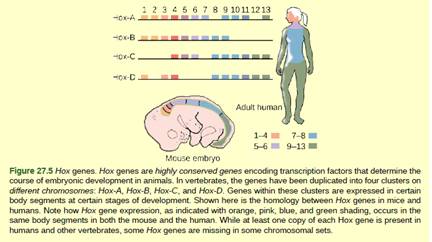
Figure 27.5 If a Hox 13 gene in a mouse was replaced with a Hox 1 gene, how might this alter animal development?

To analyze:
The development of the mouse if the Hox13 gene is replaced by the Hox1 gene.
Introduction:
Homeotic genes are the regulatory genes that control the development of body structures. One such set of genes called the Hox genes are the group of the related genes that control the body plan of an embryo along the head-tail axis.
Explanation of Solution
Among the vertebrates, humans and mice show the duplication of the Hox genes over the period of evolution. They are present in the four gene clusters on four different chromosomes called Hox- A, Hox- B, Hox- C and Hox- D. The genes within these clusters express in certain body segments at a particular stage of development.
The genes show homology in humans and mice and the genes Hox 1-4 are involved in the development of the head and the genes Hox 9-13 are involved in the development of the limbs in humans and the tail in the mouse. If a Hox- 13 gene is replaced by a Hox- 1 gene in the mouse, it might develop two heads due to the presence of two Hox-1 genes and lack a tail due to the missing Hox- 13 gene.
Thus, the replacement of Hox- 13 genes by Hox- 1 gene in the mouse can lead to the formation of a mouse with two heads and no tail.
Want to see more full solutions like this?
Chapter 27 Solutions
Biology 2e
Additional Science Textbook Solutions
College Physics
Campbell Biology in Focus (2nd Edition)
Campbell Biology: Concepts & Connections (9th Edition)
Human Physiology: An Integrated Approach (8th Edition)
Human Anatomy & Physiology
Campbell Essential Biology with Physiology (6th Edition)
- Development of an animal is controlled by the genes that are expressed during development. What roles have been proposed for Hox genes in the evolution and morphology of animal species? Group of answer choices 1. Variation in the Hox genes may have spawned the formation of many new body plans. 2. All of these descriptions are correct. 3. The number and arrangement of Hox genes varies among different types of animals. 4. Increases in the number of Hox genes may have led to greater complexity in body structure.arrow_forwardHow might differential expression of and regulation by Hox genes contribute to mosaic evolution in which different segments of an animalbody plan evolve different morphologies?arrow_forwardFigure 13-7 illustrates the expression of the Ultrabithorax(Ubx) Hox protein in developing flight appendages.What is the relationship between where the protein isexpressed and the phenotype resulting from the loss ofits expression (shown in Figure 13-1)?arrow_forward
- Review the stages of early development in animals. How are these stages similar in the animals you have studied? How do they differ? Complete Table 25.3. Thank youarrow_forwardWhich of the following is an INCORRECT statement? Question 6 options: a) The early embryo of a higher animal is never like a lower animal, but only like its early embryo. b) During the first three stages of development, blastomeres become smaller by way of each embryonic cleavage. c) The space inside of the neural tube will eventually become the space inside of the digestive system. d) A zygote results from the union of sperm and egg.arrow_forwardMany species look similar as embryos. What causes them to appear different as adults? Why does the study of development give insights into evolutionary relationships?arrow_forward
- Which statement about Hox genes is false? a. They are expressed in similar patterns in the embryos of both mice and flies. b. They include a conserved region of base pairs called the homeobox. c. They are arranged in similar clusters of genes in both mice and flies. d. They are part of the so-called genetic toolkit. e. Because of their important functional roles, they evolved rapidly in both mammals and flies.arrow_forwardExposing C. elegans to an RNAi molecule homologous to a non-protein-coding RNA gene resulted in the worms’ inability to respond to touch. What predictions could you make about the function of that gene in development?arrow_forwardExplain: Is the degenerating blastocoel visible in the frog gastrula? How much yolk protrudes through the blastopore of a frog gastrula How much yolk protrudes through the blastopore of a frog gastrula? Chickens lack a larval stage. How do they compensate for this?arrow_forward
- Why is it likely that Hox genes have played a major rolein the evolution of novel morphological forms?arrow_forwardWhy is knowing information about embryo development important?arrow_forward____ genes are regulated by segmentation genes and control the development of specific structures within particular segments. Each of these genes contains a highly conserved 180-base pair region called the ____. Examples of such genes are: ____ which regulates the development of wings in the thoracic segments and ____ which regulates the development of compound eyes and ommatidia.arrow_forward
 Biology 2eBiologyISBN:9781947172517Author:Matthew Douglas, Jung Choi, Mary Ann ClarkPublisher:OpenStax
Biology 2eBiologyISBN:9781947172517Author:Matthew Douglas, Jung Choi, Mary Ann ClarkPublisher:OpenStax Biology: The Dynamic Science (MindTap Course List)BiologyISBN:9781305389892Author:Peter J. Russell, Paul E. Hertz, Beverly McMillanPublisher:Cengage Learning
Biology: The Dynamic Science (MindTap Course List)BiologyISBN:9781305389892Author:Peter J. Russell, Paul E. Hertz, Beverly McMillanPublisher:Cengage Learning

